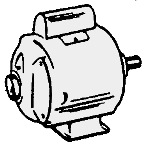October 1954 Popular Electronics
 Table of Contents Table of Contents
Wax nostalgic about and learn from the history of early electronics. See articles
from
Popular Electronics,
published October 1954 - April 1985. All copyrights are hereby acknowledged.
|
A timeless introduction for
newcomers to electronics, this article in the 1954 Popular Electronics
- the very first issue - presents
the basics of what a capacitor is and how it works. As you might expect in a
premier edition of an electronics hobbyist magazine, a lot of fundamental
information was introduced over a wide range of topics including resistor and
capacitor color codes, neon bulbs, televisions, radio control model airplanes,
amateur radio, home-built electronics projects, electronic products kit
building, model trains, stereo hi-fi equipment, solar cells, and more.
Popular Electronics pretty much stayed that course for the first decade,
and then began to adjust content to address new technologies.
What is a Capacitor?
A Primer on capacitors
 A capacitor or electric condenser, as it was
once known-is a device for storing electrical energy and returning it as desired.
It has storage space - i.e., capacity for electricity; hence, capacitor. A capacitor or electric condenser, as it was
once known-is a device for storing electrical energy and returning it as desired.
It has storage space - i.e., capacity for electricity; hence, capacitor. Basically, a capacitor consists of two plates or systems of material that are
capable of conducting electricity, separated by an insulating material. The oldest
man-made capacitor of record is the Leyden jar, a glass bottle whose inner and outer
surfaces were covered with copper foil. Invented in Holland in the mid-18th century,
it was first used in America by Benjamin Franklin in his classic experiments with
natural lightning. These Leyden Jar condensers and the glass plate condensers which
succeeded them were used in the early spark wireless sets.
Today's capacitors usually use aluminum foil electrodes or plates, although Invar
steel, copper, and tantalum plates; lead, copper, and tantalum foils; as well as
thin zinc and silver films are in use for specialized applications.
 The dielectric or insulating materials may be
paper impregnated with an oil or wax, electrolytically formed oxide films, plastic
films, ceramics, glass, air or a compressed gas. The dielectric or insulating materials may be
paper impregnated with an oil or wax, electrolytically formed oxide films, plastic
films, ceramics, glass, air or a compressed gas.
The combination of electrodes and dielectrics may be a rolled assembly such as
the ordinary "tubular" paper capacitor; a fixed or adjustable mechanical plate structure;
a disc or hollow tube; a stacked series of plates or wafers; or a series of coaxial
cylinders.
Capacitors are essential components in electronic and electrical circuits. They
are used everywhere in our modern electrical life - on power lines, TV and radio
sets, in automobiles, in aircraft, in fluorescent lamps, electric refrigerators,
air conditioners, oil burners, etc., etc.
 One capacitor manufacturer alone - Sprague Electric
Company - has made well over a billion capacitors in the last 25 years. Where do
they go? Well, remember that a table model radio uses about 15 and a table model
television set about 115. One capacitor manufacturer alone - Sprague Electric
Company - has made well over a billion capacitors in the last 25 years. Where do
they go? Well, remember that a table model radio uses about 15 and a table model
television set about 115.
Among the basic uses of this important circuit component are the suppression
of sparks across contacts as in auto distributors and fluorescent starters; filtering
or bypassing unwanted radio and TV signals; coupling electronic circuits together;
tuning circuits; reducing "waste" circulating currents by improving "power factor";
suppressing radio and TV noise; supplying electrical energy for conversion to light
in "pulsed photographic lighting systems"; and "phase splitting" or .changing the
nature of alternating current electricity supplied to motors used with various appliances.
This informative message is No.1 of a Series contributed by Sprague, the world's
largest manufacture of capacitors.
Write Sprague Products Co., N. Adams, Ma. , for complete Sprague catalog.
Posted June 24, 2021
(updated from original post on 1/9/2012)
|









 A capacitor or electric condenser, as it was
once known-is a device for storing electrical energy and returning it as desired.
It has storage space - i.e., capacity for electricity; hence, capacitor.
A capacitor or electric condenser, as it was
once known-is a device for storing electrical energy and returning it as desired.
It has storage space - i.e., capacity for electricity; hence, capacitor.  The dielectric or insulating materials may be
paper impregnated with an oil or wax, electrolytically formed oxide films, plastic
films, ceramics, glass, air or a compressed gas.
The dielectric or insulating materials may be
paper impregnated with an oil or wax, electrolytically formed oxide films, plastic
films, ceramics, glass, air or a compressed gas.  One capacitor manufacturer alone - Sprague Electric
Company - has made well over a billion capacitors in the last 25 years. Where do
they go? Well, remember that a table model radio uses about 15 and a table model
television set about 115.
One capacitor manufacturer alone - Sprague Electric
Company - has made well over a billion capacitors in the last 25 years. Where do
they go? Well, remember that a table model radio uses about 15 and a table model
television set about 115. 